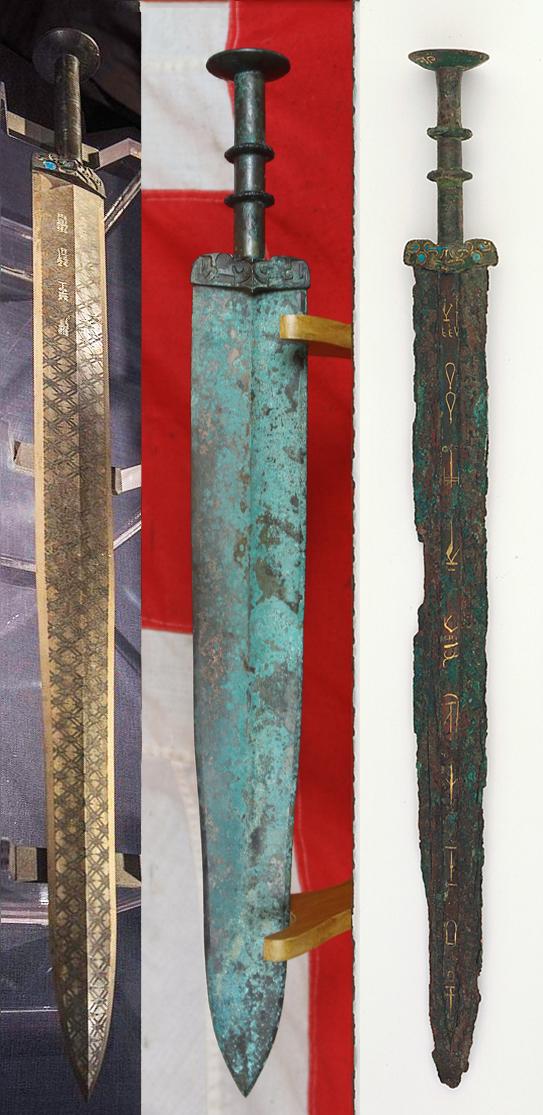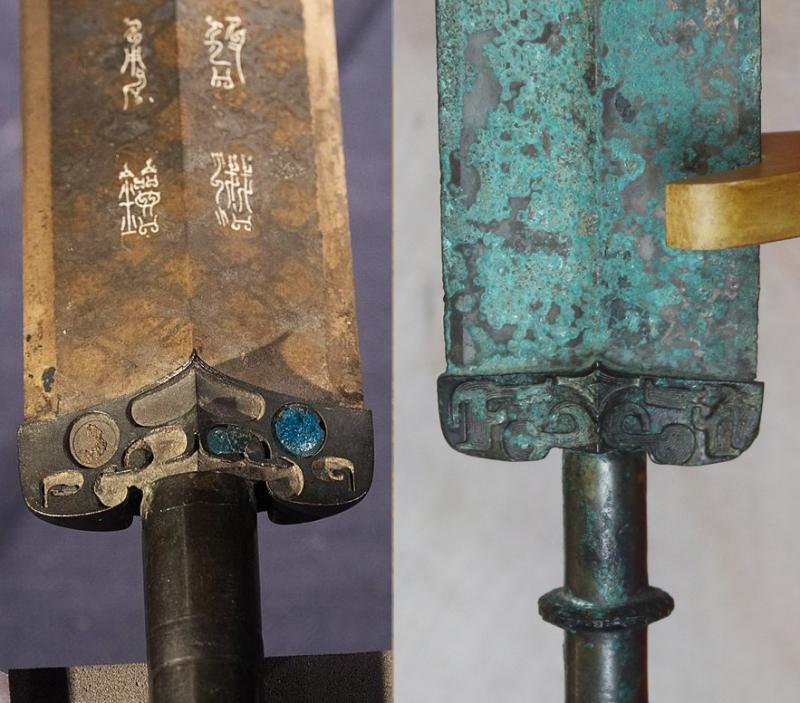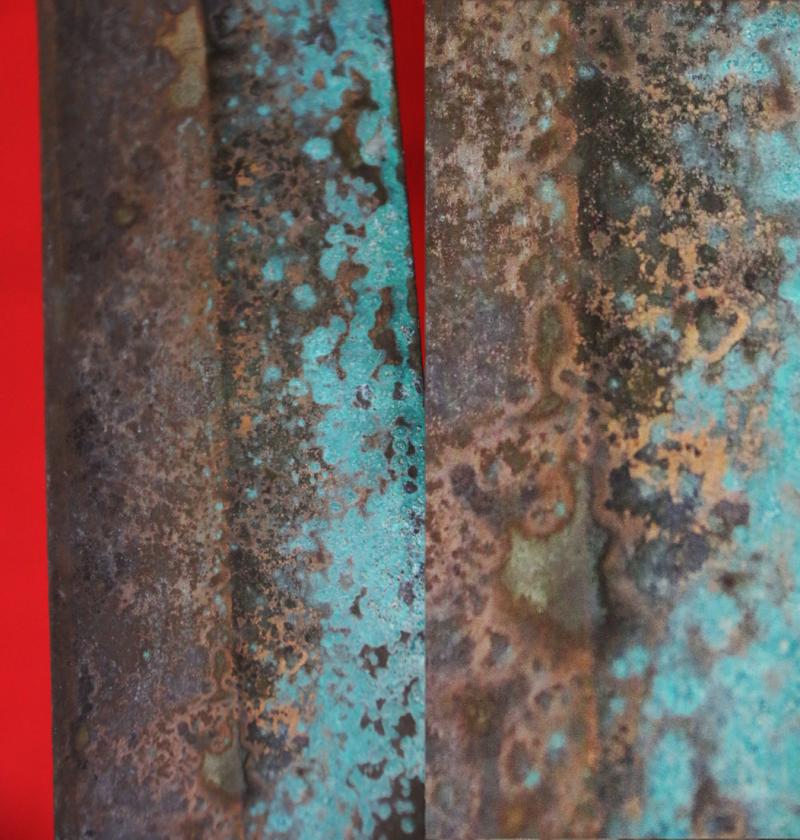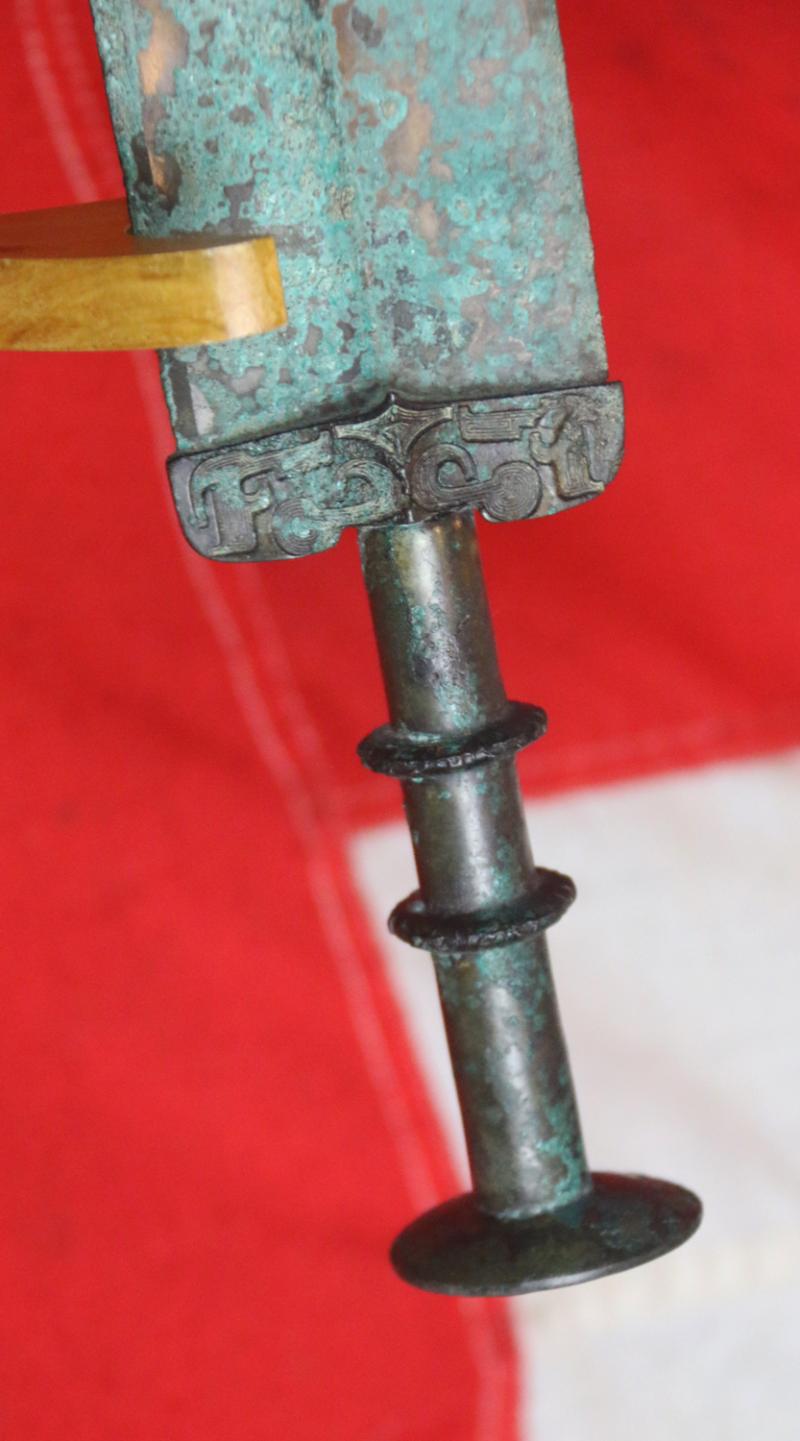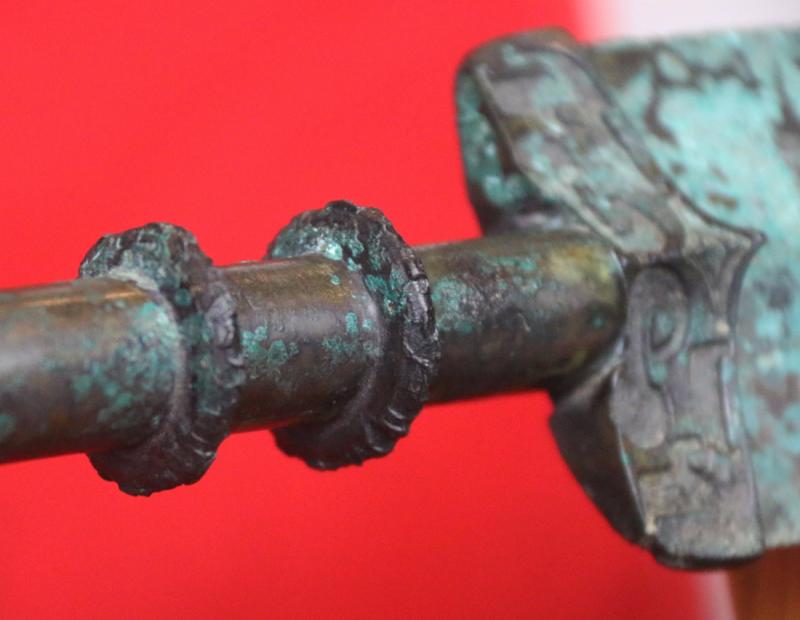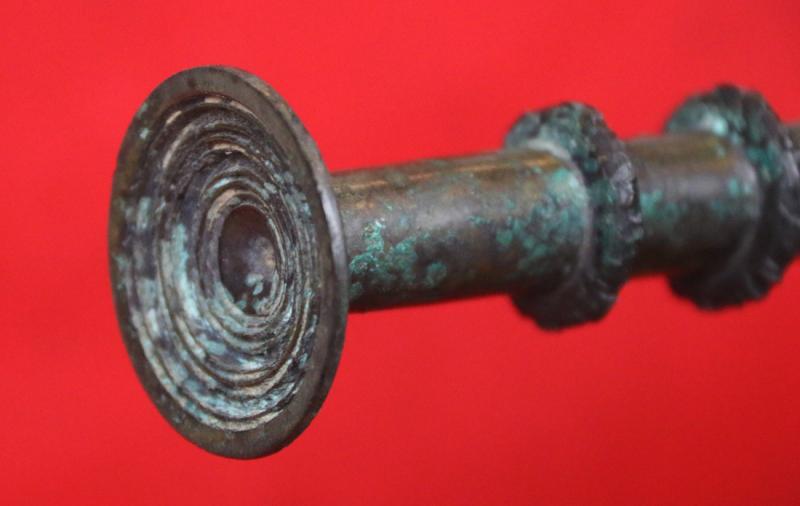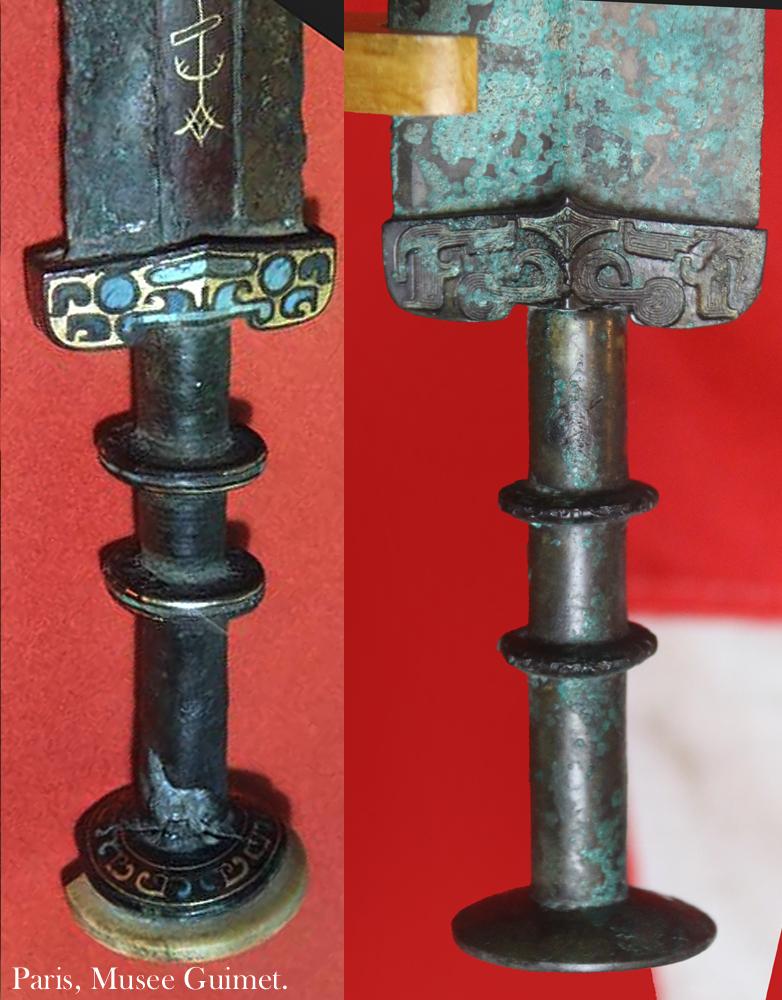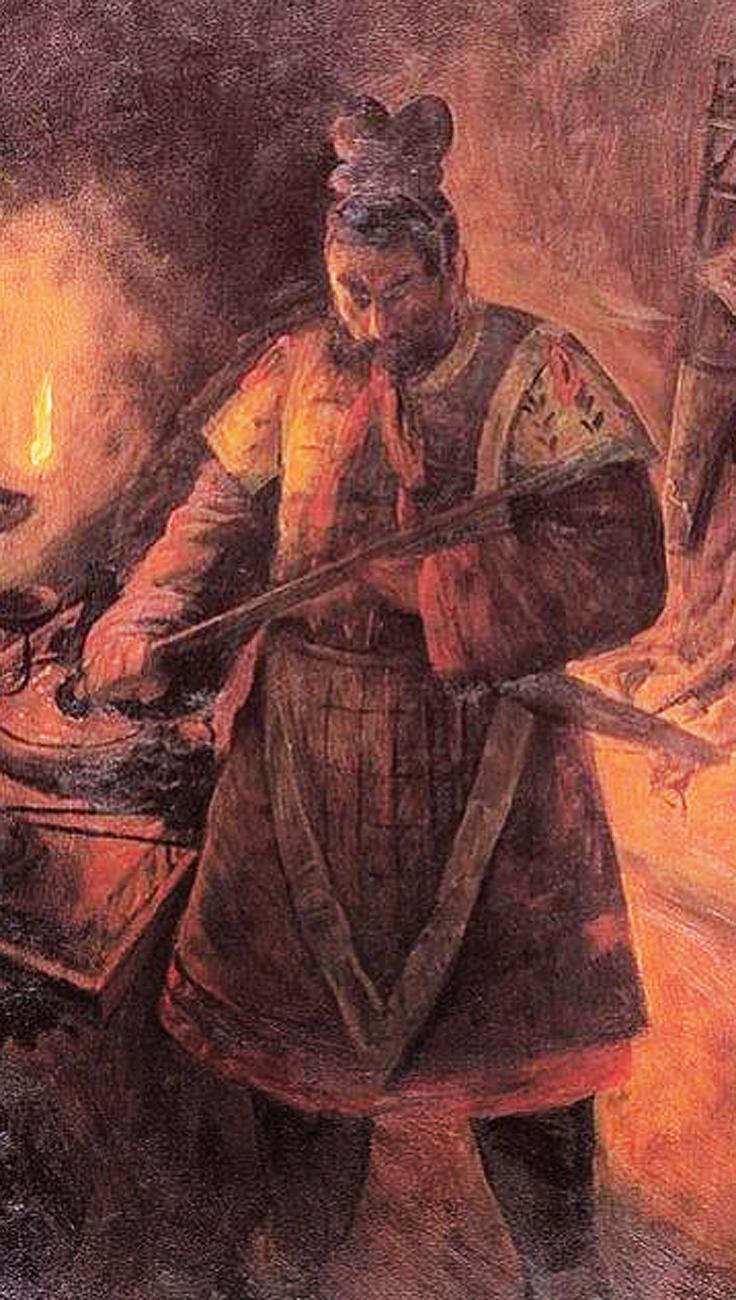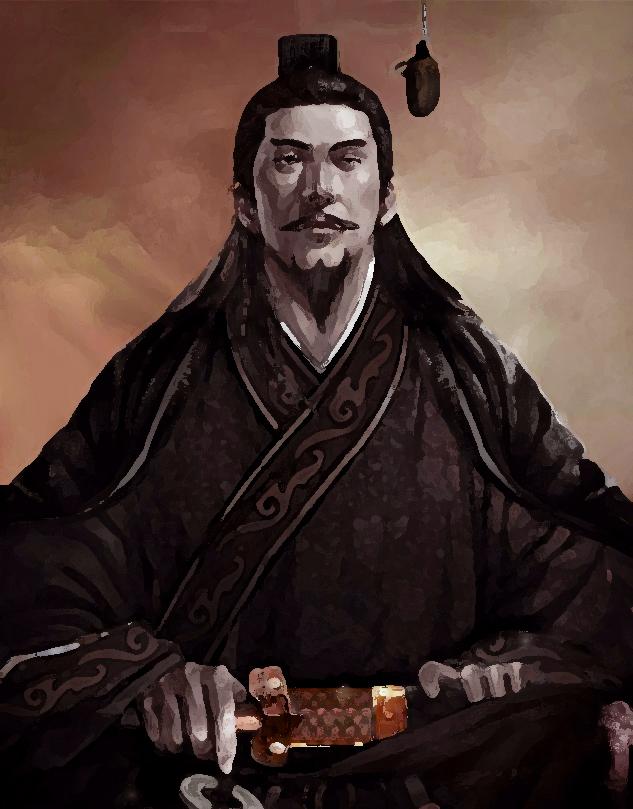We Speculate That This 2400 Year Old Sword Was Once The Sword of an Ancient Chinese King of Yueh, One Of the Nine Kings of Yueh, As It Is So Similar To The Sword of Goujian, King of Yueh, Now In The Hubei Museum in China, As to Be Remarkable
This fabulous treasure is so similar to another, that is now determined to have been made for one of the nine Kings of Yue, Goujian.
Goujian’s sword was discovered in a waterlogged tomb in the 1960's.
Ours is likely a combat fighting sword {as opposed for just for ceremonial dress, due to it's width of the blade at the ricasso}. One can see in the detailed photos this sword is covered in gold overlay but the natural ancient aging green surface encrustations now obscure most of this decor. See photo 4 in the gallery.
It was viewed the other day here by a Chinese visitor who is an assistant to the curator of an esteemed Chinese museum of antiquities, and he informed us that ancient Chinese swords such as this, decorated with enamels and gold, could only ever be carried and worn by the very highest ranked in the land.
Photo 8 shows our sword's hilt and another, very similar, to ours, very likely another King’s sword, exhibited in the Musee Guimet in Paris.
Formerly our sword was part of the Anthony Dove Collection, one of the foremost collectors of ancient Chinese swords, and joint author on the seminal academic research paper on the authentication of ancient Chinese swords and their metallurgical construction.
How often does a collector have the opportunity to acquire a fabulous sword that was likely once the sword of an ancient king.
Now known and established as 'The Sword of Goujian'. The sword in the museum in Hubei in China, has superbly chiselled or cast patterning at the forte of the blade that still contains some blue crystals and tortoise. Our sword has near identical stunning patterning {made by chiselling or casting} but our sword also has chiselling on the two grip rings and the pommel, that undoubtedly once contained the same crystals and turquoise inlays, but are no longer present.
With help from Wu's enemy Chu, Yue won after several decades of conflict. The famous Yue King Goujian destroyed and annexed Wu in 473 BC. During the reign of Wuqiang (無彊), six generations after Goujian, Yue was partitioned by Chu and Qi in 306 BC.
During its existence, Yue was famous for the quality of its metalworking, particularly its swords. Examples include the extremely well-preserved Swords of Goujian and Zhougou.
The King's Sword of Goujian still has, remarkably, all its original pure gold decor to the blade, ours has some remaining viewable as well, but much less so, due to aging.
Although the Hubei Museum’s king's sword is still amazingly sharp, thanks to its pristine condition, remarkably, so is ours. The exquisitely forged blade was made primarily of copper, but the edges likely have a higher tin content, making them harder and able to keep a sharper edge.
The Sword of Goujian still has its bird-worm script in gold engraved upon the blade face, and that script has been translated and thus after extensive research, has determined its ownership by the king, Goujian, ours may have indeed had such script, some of which is visible, possibly naming another such king, but no longer.
The Goujian King's sword, currently in Hubei Museum, has a total length of 22 inches, with a 3.3-inch hilt. The exquisitely forged blade was made primarily of copper, but the edges have a higher tin content, making them harder and able to keep a sharper edge. Both sides of the blade are decorated with a repeating rhombi pattern, their dark lines standing out from the sword’s overall golden hue. The guard, meanwhile, is inlaid with blue crystals and turquoise.
On one side of the blade are eight characters engraved in what is known as bird-worm seal script. Six of these ancient characters have been deciphered. The script reads: “King of Yue” and “made this sword for his personal use.” The other two characters could not be identified, but analysts believe that they state the name of the aforementioned King of Yueh.
These intriguing details provoked much debate as to the owner of the sword. Nine kings had ruled Yue during the period attributed to the sword, making identifying one as the true owner no easy task. But after studying both the sword and the tomb for many months, archaeologists, historians and Chinese linguists came to a consensus: The sword belonged to Goujian, who ruled the Kingdom of Yueh from 496 to 465 BC.
The earliest swords in China date back to the Bronze Age, around 1600 BC. This was a critical period in the development of ancient Chinese civilization. It was during this time that metalworking techniques were first developed and applied to the creation of weapons, swords included.
The earliest known examples of hand-forged bronze swords date back to the Shang Dynasty, and they were primarily used for ceremonial and symbolic purposes, rarely seeing real combat. The very first variations were quite simple, featuring a straight blade, some of which were single-edged and others were double-edged, as well as no guard or handle.
It wasn’t until the rise of the Zhou Dynasty that swords started becoming a lot more intricate. The blades of these swords were typically quite heavy and were often decorated with intricate patterns and designs to symbolize the prestige of the owner. Swordsmiths also began implementing a guard to their designs, as a means of protection for the wielder’s hand.
We describe below some of the known history of Goujian (句踐) (who reigned from 496–465 BC) as the king of the Kingdom of Yue (越國, present-day northern Zhejiang) near the end of the Spring and Autumn period (春秋).
He was the son of Marquis Yunchang.
Goujian's reign coincided with arguably the last major conflict of the Spring and Autumn period, the struggle between Wu and Yue, wherein he eventually led his state to victory, annexing the rival. As such, King Goujian is sometimes considered the last of the Five Hegemons.
The war between Wu and Yue comprised several separate phases. It began when a Yue princess, who was married to one of the princes of the neighboring state of Wu, left her husband and fled back to the State of Yue. This became the spark for the war to come. Also, as Yunchang developed Yue's strength, he came into conflict with King Helü of Wu, causing a feud between the two states.
Upon the death of Yunchang and the accession of Goujian, Helü seized the opportunity and launched an attack on Yue. At the Battle of Zuili (槜李之战), however, Yue defeated Wu, and King Helü was mortally wounded. Before his death, he instructed his son, the later King Fuchai of Wu, "Never forget Yue!" Yue would be defeated three years later by a resurgent Wu, and Goujian captured, to serve as Fuchai's servant for three years before he was eventually allowed to return to his native state.
Upon resuming his rule, King Goujian quickly appointed skilled politicians as advisors, such as Wen Zhong and Fan Li, to help build up the kingdom. During this time, his ministers also worked to weaken the State of Wu internally through bribes and diplomatic intrigue.
Whilst ruling his kingdom, Goujian never relished kingly riches, but instead ate food suited for peasants, as well as forcing himself to taste bile, in order to remember his humiliations while serving under the State of Wu. The second half of a Chinese idiom, wòxīn-chángdǎn (臥薪嚐膽, "sleeping on sticks and tasting gall"), refers to Goujian's perseverance.
After ten years of economic and political reforms, the last phase of the war began, by which time the State of Yue had come a long way from its previous defeat; as described in the Shiji, Ten years of reforms; the state is rich, the warriors well-rewarded. The soldiers charge in the face of arrows like thirsty men heading for drink... (修之十年,國富,厚賂戰士,士赴矢石,如渴得飲).
Taking advantage of Fuchai's expedition to his north to defeat Qi, Goujian led his army and successfully attacked the Wu capital, killing the Wu crown prince, You. In the 24th year of his reign (473 BC), Goujian led another expedition against Wu, laying siege to the capital for three years before it fell. When a surrender from Fuchai was refused, Fuchai committed suicide and Wu was annexed by Yue. After his victory, Goujian ruthlessly killed Fuchai's scholars, even those who helped him (including Bo Pi), not allowing himself to make the same mistake Fuchai had made by sparing the lives of his enemies. However, Goujian would not stop there; he would later force Wen Zhong to commit suicide; Fan Li, knowing that Goujian was a man who can share woe but not wealth together, left Goujian after the defeat of Wu.
King Goujian's army is known for a common misconception: scaring its enemies before battle with a front line formed by criminals sentenced to death who committed suicide by decapitating themselves. However, in the passage, "越王句踐使死士挑戰,三行,至吳陳,呼而自剄。", the literal translation of "死士" is "soldiers (who are) willing to die", not "criminals sentenced to death". "自剄" means to "commit suicide by cutting one's throat," which was a common way to end one's own life in Ancient China
In the gallery, photograph 2 shows our sword in the middle, to its left is the sword of Goujian, and to its right, a sword in the Metropolitan Museum. all incredibly similar, but in different stages of preservation. Photo 3 in the gallery is our sword's hilt on the left, and the Sword of Goujian on its right. the similarity is amazing. Photo 4 in the gallery is a close up of our blade sections that shows the original surface of gold, with what appears to be what remains of archaic script characters, possibly, one could speculate, it was the name of the king for whom it made and thus belonged. Photo 8 shows our sword's hilt and another, very similar, now in a Paris museum, the Musee Guimet. The Paris sword hilt still has its turquoise and enamel inlay still present and in place.
From a large collection of antiquities, swords daggers that recently arrived, many pieces sold for the part benefit of the Westminster Abbey fund, and the Metropolitan Museum fund
This is from part two of a stunning collection of original archaic bronze age Zhou dynasty weaponry . Many are near identical to other similar examples held in the Metropolitan in New York, the British royal collection, and such as the Hunan Provincial Museum, Hunan, China.
From the Tony Dove F.S.A. Collection, formed circa 1970's, one of England’s most revered and respected collectors, especially early silver, & he was a past honorary President of London’s Silver Spoon Society, and learned joint contributor to many scientific appraisals on ancient Chinese swords
Sword total length 20 1/4 inches long, 4 inch hilt
Ref; SOME OBSERVATIONS ON EARLY CHINESE BRONZE SWORDS
By
Anthony Dove, and Alan Williams {The Wallace Collection} 65 publications
Code: 24846
34995.00 GBP


